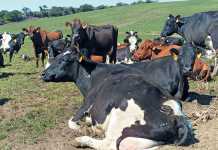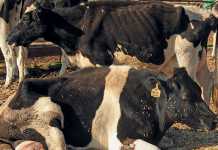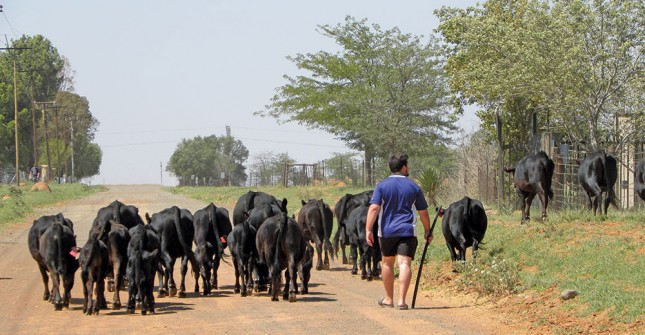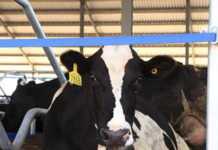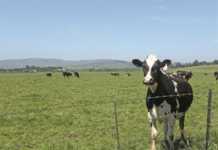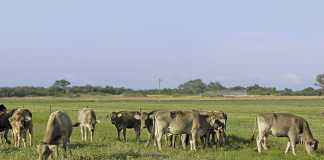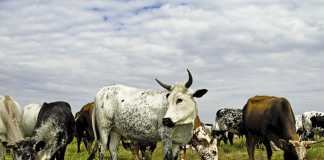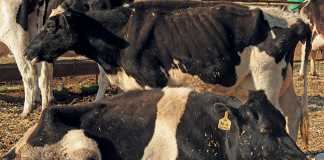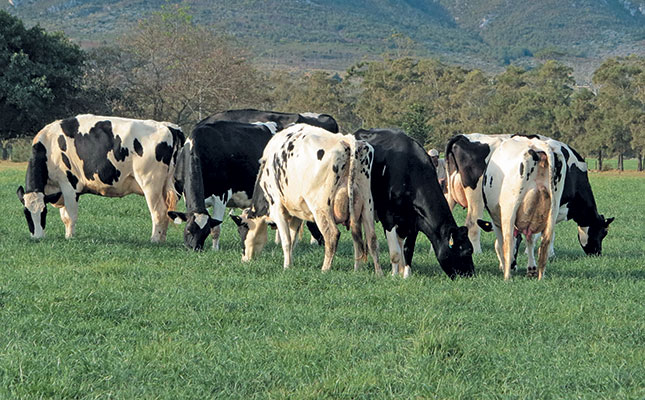
Brett Puttergill and his younger brother, Grant, are dairy farmers in the Eastern Cape, and have been farming together since 1999. In 1954, the Puttergills’ grandfather bought the family farm, Bluegums, in Thornhill on which he established a dairy operation. In 1991, Brett joined the family farming operation, and was later joined by Grant in the late 1990s.
“We have 600ha across three farms and lease another 200ha for grazing,” says Brett. “About 70ha of land is under irrigation, mostly rye grass, oats and kikuyu. Of this, we have about 40ha under pivot irrigation and the rest is draglines – and we plan to increase our irrigated land.”
The Puttergills’ dairy cows include 345 Holsteins and 40 Jerseys, and they also have a Hereford stud herd.
The dairy cattle live in the open, as the climate is generally mild, with summer temperatures seldom rising above 30°C, and the minimum winter temperatures generally stable at between 5°C and 10°C.
The switch to Holsteins and sire selection
“The family switched from Frieslands to Holsteins in the 1980s to improve production, and we’ve seen a tremendous improvement in production since then,” says Brett. “We also select strictly, and source the best bulls in the US, so we pay a lot more for semen. But the long-term benefits are definitely worth it. Sire selection is important to us.”
The bulls that the Puttergills use for insemination include Goldwyn, Shottle and Damion, Beemer, McCutchen, Troy and Monterey. They try to identify certain family lines when selecting for bulls, and also use specific genomic lines.
“We’ve found the accuracy of genomics to be very good, and are happy with the results,” Brett says.
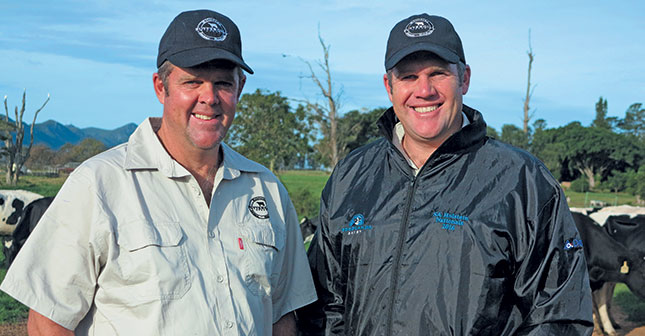
Brett (left) and Grant Puttergill.
Breeding and calving
The herd calves throughout the year, and the calving rate is usually higher in winter and spring from July to September. For the first 12 hours after birth, calves remain with their mothers. They are then hand-fed their mothers’ colostrum for the next four days.
Thereafter, they receive 4l of fresh milk daily from the dairy for three months, with 2l rations in the mornings and evenings. Heifers are artificially inseminated at 15 months, and calve at two years.
“We keep a few bull calves from select cows for breeding purposes and to sell to other farmers,” Brett says.
He adds that the Holsteins do not have many calving problems.
“The challenge is to make sure correct feeding is done, especially in the two months leading up to calving, so the calves are not too big. We generally don’t have calving problems with oversized calves that need to be pulled [out], and we also try to ensure our heifers are grown out properly before they calve for the first time.”
Bret explains that the heifers graze on natural pastures throughout their pregnancies, and receive a small concentrate supplement one month before calving to stimulate rumen.
“Supplementation with rye grass or oats silage is done during the dry months. We’ve also been using more sexed semen on our heifers, which has had a positive effect on calving with smaller calves.”
Milking regime
In April 2016, the Puttergills upgraded to a 40-point herringbone milking system, and cows are milked twice daily at 5am and 3pm. Brett explains that their pasture system does not allow milking three times a day, as the cows have to walk to graze, and pasture production is slightly lower than that in a TMR (total mixed ration) system.
“In the Western Cape and Free State, there is often zero grazing and farmers are compelled to milk three times a day to collect higher volumes in order to mitigate higher feed costs,” Brett says.
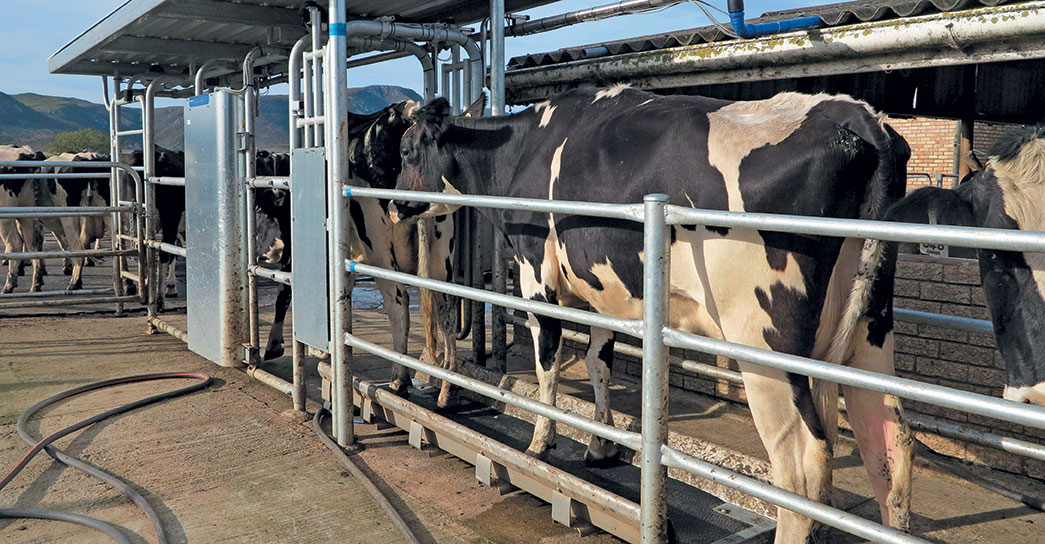
As cattle leave the milking parlour, they are weighed and all data is recorded.
Brett and Grant supply Woodlands Dairy near Humansdorp, which produces and distributes First Choice long-life milk.
“We joined when they started the factory 20 years ago,” says Brett. “We supply all we have to them and don’t have a quota system.”
Feeding
“Our cattle are fed full concentrate in the dairy, and from time-to-time there’s a select group on a full-feed ration,” says Brett.
“For example, if we have a dry spell, or are leading into winter and are still short of pasture, then we put our fresh cows onto a full-feed system, which consists of ryegrass and oats in winter, and kikuyu, teff and sorghum in summer. Concentrate feed is our single biggest expense.”
Brett explains that while being milked, each cow receives the same combination ration, but in different amounts. “They’re fed a certain number of grams/l milk produced. The formula is carefully worked out according to body weight and production.”
The numbers
Winter and spring milk production (June to October) is higher than summer production, with cows producing roughly 3l more per day, as feed and pasture quality is more challenging to maintain in summer.
Grant says that the Holsteins average 10 038kg per lactation, with 3,87% butterfat, 3,09% protein and an ICP (inter-calving period) of 417 days. Jerseys average 7 099kg per lactation with 4,78% butterfat, 3,61% protein and an ICP of 402 days. The daily average production per cow across the mixed herd is 28l.
“We feed 330g/l, which translates into about 9kg concentrate per cow. The all-time highest producer at 74l/ day is Puttergill Baxter Parma 938, and she still manages 41,1l/ day. She has produced 17 047l during this lactation.
“The average productive lifespan is just over three lactations per cow. But the oldest cow in the herd is 16 years old. “Few cows go over 10 years old as high producers. We also don’t carry any passengers. It’s important to know what works on your specific farm, and bigger is not necessarily better.”
The Puttergills employ 24 staff, with six working in the dairy.
Diseases, vaccination and hygiene
Grant says that brucellosis and lumpy skin disease are the herd’s greatest disease threats, and their cows are vaccinated against both.
Tick-borne illnesses such as redwater and heartwater are also problematic, particularly when farming near the coast, so the Puttergill cattle are dipped regularly. Dipping the herd is one of the most time-consuming practices of their operation.
Mastitis is always a concern in cows producing large volumes, but Grant explains that they run somatic cell counts on milk samples to detect cows with subclinical mastitis.
The dairy licence is renewed annually, and the muncipality thus conducts yearly inspections. Woodlands Dairy has stringent hygiene standards, and milk is inspected on arrival at its factory. The Puttergills also submit daily check sheets to Woodlands every month. In addition, an independent auditor inspects the dairy annually, checking the lighting, cleaning equipment, medicines, check sheets and protocols.
Staying viable through steady improvement
“We both do everything on the farm, but Grant does more marketing, statistics and computer work, and I have more to do with the pastures, vaccinations and cattle,” says Brett.
Grant adds that to ensure the viability of a dairy farm, it is important to keep up with the times and consumer demands.
“Breeding plays a big role in our success and we’re continually improving our genetics by using the best semen stock available to maximise milk production, health and the longevity of our cows. We also look after our animals properly.
With rising feed costs, we have to have high-producing cows, so we must feed them correctly. We concentrate on getting the highest production possible from a cow off pasture.”
According to Grant, cheap milk imports affect the entire dairy industry, and one of the greatest challenges for dairy producers is the large price gap between what consumers pay per litre of milk in supermarkets, and what producers receive per litre.
However, despite these challenges, Grant insists that farming is still worth it.
“There is nothing we’d rather be doing than farming dairy. There are more positives than negatives, and while it’s hard work, it’s also rewarding. When you breed that good cow, it’s a great feeling, and you know you’ve done something right.”
Brett adds that their interest in farming was nurtured in childhood.
“We love working with animals. And we also try to get our kids involved so they pick up on things from an early age. You have to have passion for what you do.”
Visit puttergillfarming.com.
Issue Date: 26 August 2016

